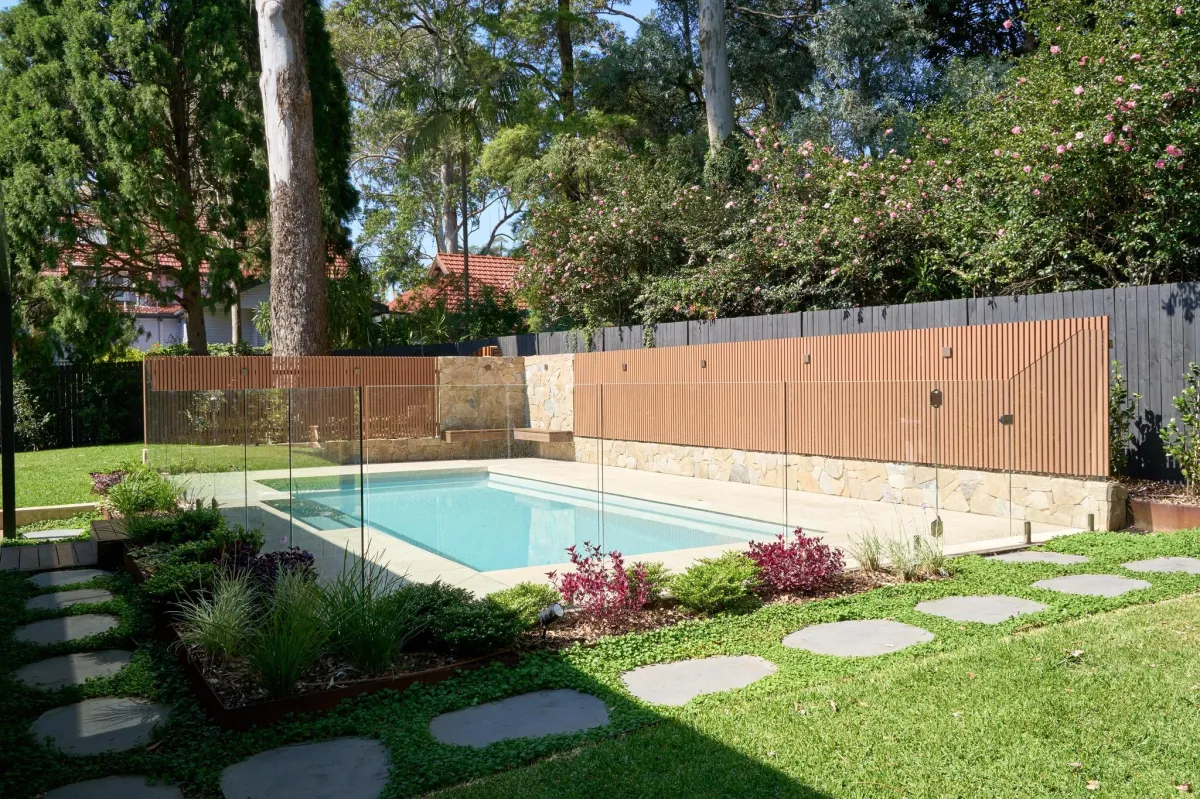
Pool Building In NSW: Real Costs, Approvals, And Design Choices That Save You Thousands

Blog: December 2025
Pool Building In NSW: Real Costs, Approvals, And Design Choices That Save You Thousands

Thinking about a pool before summer hits? If you are in Sydney or the Central Coast, you are not alone. The warm weather, coastal breezes and hilly blocks across suburbs like Terrigal, Wamberal and North Avoca mean a pool can be both a lifestyle win and a design challenge. This guide sets realistic expectations on cost, approvals, timelines and smart design choices that trim the budget without sacrificing the look. You will walk away with clear numbers for NSW, what to prioritise, and when to bring in a specialist team for a stress-free build.
The real cost to build a pool in NSW
Pricing varies with site conditions, soil, access and finishes, but these are realistic consolidated ranges for 2025 planning in NSW:
Fibreglass pool shell and installation: from $35,000 to $70,000 for common sizes and shapes. Premium shells, long cranes or complex access can push that to $80,000 plus.
Concrete pool structure: typically $60,000 to $120,000, with fully custom shapes, deep ends and high-spec finishes often landing between $90,000 and $180,000.
Surrounds and hardscape: coping, paving or tiling, drainage, and allowance for falls usually add $12,000 to $40,000 depending on area and stone choice.
Fencing and compliance: $4,000 to $15,000 based on glass versus aluminium, gate hardware and terrain.
Services and equipment: filtration, pumps, chlorination or mineral systems, lighting and automation often add $6,000 to $20,000.
How much should you budget for a pool? For a neat, family-size fibreglass install with attractive but sensible surrounds, most NSW homeowners should plan a total budget of $55,000 to $110,000. A bespoke concrete design with high-spec paving and retaining commonly sits between $110,000 and $220,000.
Fibreglass vs concrete, and how to pick
Fibreglass
Best for: predictable timelines, smooth interior, lower chemical demand, clean modern shapes.
Pros: rapid install, consistent factory finish, often backed by lifetime warranties, easy maintenance.
Cons: set sizes and shapes, limited custom steps or ledges compared with concrete.
Concrete
Best for: fully custom geometry, deep ends, integrated benches and unique site responses.
Pros: total design flexibility, premium aesthetic options, excellent for tricky blocks or architectural briefs.
Cons: longer build time, higher upfront cost, more finishing trades to coordinate.
If you value speed, smooth finishes and strong longevity, a fibreglass pool is an excellent choice. How long do fibreglass pools last? With correct installation, balanced water chemistry and routine care, quality fibreglass
shells are commonly serviceable for 25 to 35 years or more. Many manufacturers offer lifetime structural warranties, and well-designed surrounds will protect the shell and plumbing for the long term.

What is the cheapest inground pool and shape?
The cheapest inground pools in NSW are generally standard-size fibreglass shells installed with straightforward access. The cheapest pool shape is usually a simple rectangle or a small rectangular plunge model.
Rectangles optimise shell manufacturing and minimise complex excavation, formwork, and coping cuts. Freeform shapes can be stunning, but curves usually add cost in coping, tiling and labour.
Tip: choose a shell size that avoids a crane road closure or power shutdown. Transport and cranage can be silent budget killers if not planned early.
The most expensive parts of building a pool
Excavation on difficult sites: rock, tight access, steep slopes and coastal sand that needs shoring can add thousands. On some blocks, excavation is the single largest variable cost.
Concrete construction and finishing trades: steel, concrete, waterproofing and interior finishes stack up quickly.
Premium surrounds: large-format porcelain or natural stone, intricate drainage and detailed coping profiles deliver a resort finish, but they require skilled installation.
Structural works around the pool: retaining walls, engineered footings, new drainage and safe access paths.
Fully frameless glass fencing: beautiful, but often two to three times the cost of aluminium solutions.
Approvals and compliance in NSW
Do you need council approval for a pool in NSW? Yes, you will typically need a Development Application or can proceed under a Complying Development Certificate depending on zoning and constraints. You must also
meet the Swimming Pools Act 1992 and the Swimming Pools Regulation 2018, which set out barrier standards, gate self-closing requirements and non-climbable zones.
Key compliance points
Fencing and gates: a compliant, self-closing gate, correct latch height, correct fence height and clear non-climbable zones.
CPR sign: visible signage near the pool.
Final inspection and certificate: you will need a final barrier compliance certificate before use.
A competent builder will coordinate approvals, engineering, boundary offsets and service checks to keep your project moving.
Excavation on coastal and sloping blocks
Sydney and the Central Coast combine sandstone, fill and beach sand. On sloping coastal blocks, you may encounter:
Sand and groundwater: plan for dewatering, stronger footings and robust drainage.
Sandstone or rock: allow contingency for rock breaking or saw cutting.
Access constraints: narrow driveways, overhead power and neighbours. Early cranage planning avoids surprises.
Smart savings
Trim the pool size slightly to reduce excavation and spoil removal.
Use terracing and integrated retaining so the pool sits into the slope cleanly, with safe steps and landings.
Consolidate trades: when one team handles excavation, retaining, drainage and paving, interface risks drop and costs often follow.
Timelines you can rely on
For fibreglass, a typical sequence looks like this:
Site assessment and design: 1 to 2 weeks
Selections and contract: 2 to 3 weeks
Manufacture and approvals: 4 to 6 weeks
Installation and surrounds: 6 to 10 weeks depending on site and scope
Concrete pools run longer due to formwork, curing and finishing, commonly 12 to 20 weeks from approvals to handover on an average project.

Designing safe, stylish surrounds
Surrounds make or break the result. Keep it safe, cool underfoot and easy to maintain.
Coping and paving: porcelain or travertine with slip ratings and correct falls to drainage. Extend the finish through adjacent paths for continuity.
Drainage: integrate ag lines, geofabric and gravel backfill behind retaining. Proper drainage prevents movement and staining.
Shade and privacy: pergolas, screens and layered planting provide comfort and soften boundaries.
Lighting: low-glare path lighting and step markers improve night-time safety around water.
On coastal sites, select materials that resist salt and UV. Stainless fixings, slip-rated stone and thoughtful detailing lift both longevity and day-to-day comfort.
Do pools add value in NSW, and is a pool a good investment?
In many Sydney and Central Coast suburbs, buyers expect a well-presented outdoor area. A pool that is proportional to the block, compliant, and integrated with quality landscaping can attract more interest and support
stronger sale prices, especially in family-friendly and lifestyle-focused suburbs. Does a pool add value to your house in NSW? Often yes, provided it is well designed, safe, and not a maintenance burden. Is a pool a good
investment in Australia? It can be, if you match the design to your market and maintain it well. Think lifestyle value plus saleability. Overcapitalisation is the risk to avoid, which makes early budgeting and site-led design essential.
Ways to save without regret
Choose a standard fibreglass shell size to reduce manufacturing lead times, transport and cranage complexity.
Keep the pool closer to the house for service connections and safer supervision.
Opt for a clean rectangular shell with straight coping to reduce cutting and labour.
Stage features: build the pool and essential surrounds first, then add the outdoor kitchen, pergola or upgraded tiling later.
Focus on drainage and structure first; cosmetic fixes are easier to upgrade than poor subsoil works.
Who to trust with the build
You want a team that manages approvals, excavation, shell install or concrete build, coping, paving, fencing and planting as a single, coordinated program with tidy site cleanup. If you are planning on the Coast, explore pool installation central coast services with a team that integrates drainage, retaining walls and paving into one streamlined delivery.
FAQ quick answers
How much does it cost to build a pool in NSW? From about $35,000 for basic fibreglass shells, through $55,000 to $110,000 for typical turnkey fibreglass setups, and $110,000 to $220,000 for bespoke concrete with premium surrounds.
How much should I budget for a pool? Start with your preferred pool type, then add surrounds, fencing, and a contingency of 10 to 15 percent. For many homes, $80,000 to $140,000 covers a high quality result.
What is the cheapest inground pool to put in? A standard-size fibreglass shell with straightforward access.
What shape pool is the cheapest? A small rectangle or plunge format with straight coping lines.
What is the most expensive part of building a pool? Difficult excavation, concrete structures and premium surrounds, plus frameless glass fencing.
Do you need council approval for a pool in NSW? Yes, via DA or CDC pathways, plus mandatory barrier compliance.
How long do fiberglass pools last? Commonly 25 to 35 years or longer with correct care and installation.
Does a pool add value to your house in NSW, and is a pool a good investment in Australia? Often yes, when the design is proportional, compliant and well maintained.
Ready to plan your pool?
Book a site assessment with Key Landscaping to get a tailored plan for your block, budget and timeline, including approvals, excavation strategy and a clear finish schedule. Our team supplies and installs fibreglass pools, coordinates surrounds and drainage, and manages fencing and planting for a resort-style finish that lasts. If you also plan a deck to connect your living area to the pool zone, speak with a deck builder central coast that understands coastal exposure, slip ratings and smart subframes. Prefer a full-site solution with planting, retaining and paving coordinated from day one? Work with an experienced landscaper central coast partner that delivers design, construction and tidy handover with premium ongoing support.
Summary: keep the shape simple, plan for site realities, prioritise drainage and compliant fencing, and pick materials that look great and stay cool underfoot. With the right design choices and a coordinated team, you will enjoy a safe, stylish pool that adds genuine lifestyle value and strong buyer appeal.
